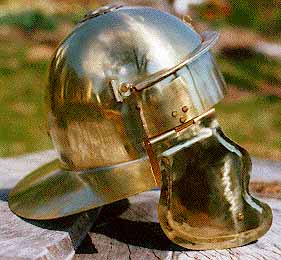

MAKING HELMETS FROM SPUN BRASS DOMES 2/6/08
 |
 |
| Coolus H helmet made by Matthew Amt. Robinson's
"type 24" cheekpieces. (These 2 photos copyright Jane Walker.) |
Alem helmet, as shown in Simkins' Warriors of Rome, p. 64. Essentially a Coolus type I. "Type 21" cheekpieces. Also made by Matthew Amt, for George Metz of Legio XXIV. |
Many Roman brass helmets were made by spinning, forcing a sheet of metal down over a form on a lathe. It is faster (and was therefore cheaper) than forging the bowl to shape by hammering, but could not be done with iron due to its hardness and slag inclusions.
Our metal spinner is
Maryland Metal
Spinning, Inc., 5219 Fairlawn Ave., Baltimore, MD 21215, phone
410-466-6400.
(See below for other spinning companies.) Our order of 20 bowls
came
to $65 apiece, but on smaller orders the cost would be higher.
They are 16-guage yellow brass, 8-1/2 inches in diameter with a 1-3/4"
to 2" "straight" to make them about 6" deep. Assuming the place
is
still in business, they said they would keep the die they spun these on
for 5 years, but that was back in February 1996. If a die has to
be made for the job, several hundred dollars could be added to the
total cost. The size is all right--the
nice Drusenheim Coolus G that everyone copies is 8-1/2" in diameter and
was spun--but 8-1/4" or even 8" would probably work fine, and not look
quite so large on smaller heads. You can do a certain amount of
"squashing"
to narrow the bowl, of course, and some spun originals are longer than
they are wide. But it helps to remember that if the size is
authentic,
it doesn't really matter if it looks too big--that's how it would have
looked on a real Roman!
The catch is that if you want
a different size but the company does not happen to have a die that
size,
you'll have to pay a tooling cost of a couple hundred bucks. We
were
lucky, and he already had the ball that he used for our bowls, so see
what
they have.
It should be possible to get bowls spun with a more-or-less flat brim which could simply be trimmed to the desired neckguard shape, since that is what the Romans did. Our spinner didn't think that could be done, and it would certainly raise the cost. One of the Australian groups got steel domes spun with brims, but said that the brass ones could not be done that way because of the stress to the metal. One advantage to bowls without brims is that the height of the dome can be left tall or trimmed down, depending on the helmet being reproduced.
Assuming your bowls have no brims, 18 or 16-ga sheet brass will be needed for the neckguards, and 18 or 20-ga for the cheekpieces and brow reinforces. Cheekpieces with ridging are easier with 20-ga; bend coat hanger wire into the shapes needed and tape to the back of the piece, then hammer (with leather or lead block underneath). The "stepped-down" edges can be accomplished simply by bending down and then back up with pliers--use smooth-jawed pliers or make brass jaw pads to avoid bad "teeth marks". Solid brow reinforces can be bent from 3/16"x1/2" rectangular brass bar, though it will need to be annealed several times.
Our neckguards were all brazed on with an oxy-acetyline torch, and I don't know what other kinds of welders would work. The brazing rod used turned out to be slightly redder in color than the metal, but that made no significant difference. The seam needs to be smoothed, inside and out, to the point where bowl and neckguard appear to be made in one piece. A Dremel tool or similiar small grinder is best for removing most of the unwanted seam, then work with a selection of files to get an even line. Make sure that you don't grind into the metal of the bowl or neckguard.
If you are copying a helmet
which
was spun originally you can leave the spin marks on the bowl.
They
can be removed, however, with fine sandpaper on a sanding disc;
following
that with progressively finer abrasives and buffing should give a
mirror-polish.
This is a little easier to do before the neckguard is welded on, but
you
will have to redo the section around the seam. Remember that any
STEEL helmet made from a spun bowl must not show spin marks at all,
since original iron helmets were never spun.
Other metal-spinning companies:
Spun Metals, Inc.
4840 S 33rd Street
Phoenix, AZ 85040
602-268-8771
http://www.plantfloor.com/az/spunmetalsinc.htm
A Metal Spinning Directory--http://www.metal-spinners.net/
Click here for more Metalworking hints.
----------
*Home*Handbook Intro*Tunic*Caligae*Cloak*Belt*Helmets*Segmentata*Hamata*Squamata*Subarmalis*Scutum*Gladius*
*Pilum*Pugio*Packs*Mess
Gear*Tools*Crests*Drill*Leatherworking*Armoring*
----------
*Home*Schedule*Handbook
*Auxiliaries *Civilian
Clothing *Cold-Weather Clothing *Signum*LINKS*SUPPLIERS*Bibliography
*
*ADLOCVTIO*Tent
and Camp *Roman Days*History*Names
*Advice
on Starting a Group *PHOTOGRAPHS*Bylaws
*Membership*